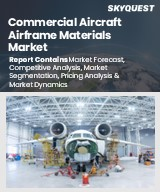
세계의 민간 항공기 기체 재료 시장 규모는 2023년에 51억 달러로 평가되었고, 2024년 55억 7,000만 달러에서 2032년에는 112억 6,000만 달러로 성장할 전망이며, 예측 기간인 2025-2032년 CAGR 9.2%로 성장할 것으로 예측됩니다.
민간 항공기 기체 재료 시장은 현대 항공기 제조에 필수적인 경량, 고강도 및 비용 효율적인 재료에 대한 수요가 높아짐에 따라 상당한 성장이 예상되고 있습니다. 최근의 동향에서는 복합재료, 알루미늄합금, 티타늄 등 첨단재료로의 이행이 진행되고 있으며, 이들 재료는 강도 대 중량비, 내식성, 내구성을 높여 보다 광범위한 지속가능성 목표에 부합하고 있습니다. 신흥국 항공기 신규 발주 수요 증가와 신흥국 시장의 노후화된 항공기 대체 수요가 주요 성장 촉진 요인입니다. 게다가 제조사는 구조적인 무결성을 유지하면서 승객의 안전 및 쾌적성을 우선시하는 캐빈 재료를 혁신하고 있습니다. 항공 분야가 최근의 불황에서 회복하는 가운데 연구 개발에 대한 지속적인 투자와 참신한 생산 기술의 채택이 이 시장의 장래 전망을 형성할 것으로 생각됩니다.
Global Commercial Aircraft Airframe Materials Market size was valued at USD 5.1 billion in 2023 and is poised to grow from USD 5.57 billion in 2024 to USD 11.26 billion by 2032, growing at a CAGR of 9.2% during the forecast period (2025-2032).
The commercial aircraft airframe materials market is poised for substantial growth, driven by heightened demand for lightweight, high-strength, and cost-effective materials crucial for modern aircraft manufacturing. Recent trends favor the transition to advanced materials like composites, aluminum alloys, and titanium, which enhance strength-to-weight ratios, corrosion resistance, and durability, aligning with broader sustainability goals. The rising demand for new aircraft orders from emerging economies and the need to replace aging fleets in developed markets are key growth drivers. Additionally, manufacturers are innovating cabin materials that prioritize passenger safety and comfort while maintaining structural integrity. As the aviation sector rebounds from recent downturns, continued investment in R&D and the adoption of novel production techniques will shape the future landscape of this market.
Top-down and bottom-up approaches were used to estimate and validate the size of the Global Commercial Aircraft Airframe Materials market and to estimate the size of various other dependent submarkets. The research methodology used to estimate the market size includes the following details: The key players in the market were identified through secondary research, and their market shares in the respective regions were determined through primary and secondary research. This entire procedure includes the study of the annual and financial reports of the top market players and extensive interviews for key insights from industry leaders such as CEOs, VPs, directors, and marketing executives. All percentage shares split, and breakdowns were determined using secondary sources and verified through Primary sources. All possible parameters that affect the markets covered in this research study have been accounted for, viewed in extensive detail, verified through primary research, and analyzed to get the final quantitative and qualitative data.
Global Commercial Aircraft Airframe Materials Market Segments Analysis
Global Commercial Aircraft Airframe Materials Market is segmented by Material Type, Application Types and region. Based on Material Type, the market is segmented into Aluminium alloys, Titanium alloys, Composites and Steel alloys. Based on Application Types, the market is segmented into Commercial Aircraft, Helicopters, Business & General Aviation and Others. Based on region, the market is segmented into North America, Europe, Asia Pacific, Latin America and Middle East & Africa.
Driver of the Global Commercial Aircraft Airframe Materials Market
The demand for environmentally friendly aviation and stringent regulatory measures are significant drivers in the Global Commercial Aircraft Airframe Materials market. Airlines are increasingly seeking lighter and more efficient aircraft to meet these evolving expectations. Regulatory bodies are establishing new efficiency standards for upcoming aircraft, focusing on reducing emissions and fuel usage. In response to these challenges, manufacturers are innovating by introducing advanced airframe materials, such as state-of-the-art carbon composites, which not only reduce weight but also contribute to lower pollution levels, thereby enhancing overall aircraft efficiency. This alignment with green initiatives is shaping the future of the industry.
Restraints in the Global Commercial Aircraft Airframe Materials Market
The Global Commercial Aircraft Airframe Materials market faces notable restraints due to the high costs associated with adopting new materials and production techniques. The use of specialized alloys and composite materials requires custom tooling, stringent quality control measures, and skilled labor, all of which significantly elevate production and maintenance expenses. For example, the fabrication of composites demands meticulous processes, which, while offering performance enhancements, ultimately drives project costs higher. These financial challenges may impede the widespread adoption of innovative materials in aircraft manufacturing, potentially affecting the overall growth and evolution of the market.
Market Trends of the Global Commercial Aircraft Airframe Materials Market
The Global Commercial Aircraft Airframe Materials market is experiencing a significant shift towards thermoplastic composites, driven by original equipment manufacturers (OEMs) seeking innovative materials that enhance production efficiency without sacrificing structural integrity. Unlike traditional thermoset composites, thermoplastics facilitate reshaping and reprocessing, making them ideal for automated, high-volume manufacturing. The 2024 investment by Airbus in thermoplastic processing at its Bremen facility underscores this trend, showcasing a commitment to sustainable practices while enhancing manufacturability. This transition not only meets the growing demand for lightweight, durable materials but also aligns with the aerospace industry's focus on eco-friendly production methodologies, reshaping future aircraft design.